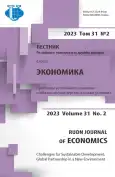Stability of the global financial system as a factor in the post-crisis recovery of the world economy
- 作者: Smirnov E.N.1
-
隶属关系:
- State University of Management
- 期: 卷 31, 编号 2 (2023): CHALLENGES FOR SUSTAINABLE DEVELOPMENT: GLOBAL PARTNERSHIP IN A NEW ENVIRONMENT
- 页面: 282-298
- 栏目: Monetary and financial questions
- URL: https://journal-vniispk.ru/2313-2329/article/view/324333
- DOI: https://doi.org/10.22363/2313-2329-2023-31-2-282-298
- EDN: https://elibrary.ru/AAOHVL
- ID: 324333
如何引用文章
全文:
详细
The purpose of the study was to assess the adaptability of the global financial system to the crisis phenomena observed in recent years in the world economy. In particular, the key financial risks of the development of the global economy and the opportunities for their neutralization were identified, the role and possibilities of monetary policy in overcoming the current unprecedented inflation were shown, and the possibilities of transition to sustainable growth based on curbing inflation on short-, mediumand long-term trends were identified. development of the world economy. A special role in our study was played by the substantiation and development of mechanisms for the rational management of public debt, which plays a fundamental role for a fair recovery of the world economy.
作者简介
Evgeny Smirnov
State University of Management
编辑信件的主要联系方式.
Email: smirnov_en@mail.ru
ORCID iD: 0000-0002-9325-7504
Doctor of Economics, Professor, Acting Head of the Department of World Economy and International Economic Relations
99 Ryazansky prospect, Moscow, 109542, Russian Federation参考
- Aturin, V.V., & Grigoryan, K.G. (2014). The crisis of economic science and the interests of the state in the context of financial and economic globalization. Bulletin of the University, 21, 67–70. (In Russ.).
- Kirillov, V.N., & Miller, Ya.V. (2021). Global value chains in the context of new challenges in the development of the world economy. Russian Foreign Economic Bulletin, 2, 86–97. (In Russ.).
- Smirnov, E.N., & Karelina, E.A. (2021). Some Aspects of Global Financial Stability in the Context of the Coronavirus Pandemic. Financial Markets and Banks, 2, 43–48. (In Russ.).
- Smirnov, E.N., & Lukyanov, S.A. (2021). Instability of international trade and approaches to optimal regulation. Manager, 5(12), 21–31. (In Russ.).
- Araujo, A.P., Ferreira, R., & Funchal, B. (2012). The Brazilian Bankruptcy Law Experience. Journal of Corporate Finance, 18(4), 994–1004.
- Asonuma, T., & Trebesch, C. (2016). Sovereign Debt Restructurings: Preemptive or Post-Default. Journal of the European Economic Association, 175–214.
- Black, S., Parry, I., Roaf, J., & Zhunussova, K. (2021). Not Yet on Track to Net Zero: The Urgent Need for Greater Ambition and Policy Action to Achieve Paris Temperature Goals. IMF Staff Climate Note, 2021/005. International Monetary Fund (IMF), Wash., DC, 30 p.
- Borensztein, E., & Panizza, U. (2008). The Costs of Sovereign Default. IMF Staff Papers. WP/08/238, 50 p.
- Chateau, J., Jaumotte, F., & Schwerhoff, G. (2022). Economic and Environmental Benefits of International Cooperation on Climate Policies. IMF Research Department Paper, (7). International Monetary Fund (IMF), Wash., DC, 41 p.
- Cloyne, J., & Hürtgen, P. (2016). The Macroeconomic Effects of Monetary Policy: A New Measure for the United Kingdom. American Economic Journal: Macroeconomics, 8(4), 75–102.
- Fonseca, J., & Van Doornik, B. (2020). Financial Development and Labor Market Outcomes: Evidence from Brazil. Working Paper, 532, Research Department, Central Bank of Brazil, 70 p.
- Furceri, D., & Zdzienicka, A. (2012). How Costly Are Debt Crises? Journal of International Money and Finance, 31(4), 726–742.
- Gadgil, S., Ronald, B., & Vyakaranam, L. (2019). Timely Resolution of Cases under the Insolvency and Bankruptcy Code. Journal of Critical Reviews, 6(6), 156–167.
- Giné, X., & Kanz, M. (2018). The Economic Effects of a Borrower Bailout: Evidence from an Emerging Market. Review of Financial Studies, 31(5), 1752–1783.
- Giné, X., & Love, I. (2006). Do Reorganization Costs Matter for Efficiency? Evidence from a Bankruptcy Reform in Colombia. Policy Research Working Paper, 3970. World Bank, Wash., DC, 42 p.
- Kose, M.A., Ohnsorge, F., Reinhart, C.M., & Rogoff, K.S. (2021). The Aftermath of Debt Surges. Policy Research Working Paper, 9771. World Bank, Wash., DC, 33 p.
- Lim,Y., & Hahn, C. (2003). Bankruptcy Policy Reform and Total Factor Productivity Dynamics in Korea: Evidence from Macro Data. NBER Working Paper, 9810. National Bureau of Economic Research (NBER), Cambridge, MA, 297–326.
- Parry, I., Black, S., & Roaf, J. (2021). Proposal for an International Carbon Price Floor among Large Emitters. IMF Staff Climate Notes, 2021/001. International Monetary Fund (IMF), Wash., DC, 18 p.
补充文件









